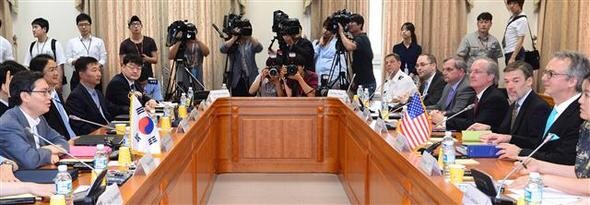hankyoreh
Links to other country sites 다른 나라 사이트 링크
Looking to Japan-US cost sharing agreement as negotiations start in Korea

By Gil Yun-hyung, staff reporter
On July 24, the second session of negotiations for the ninth defense cost-sharing Special Measures Agreement (SMA) began to determine how much financial support the South Korean government will provide the US military for stationing costs, starting in 2014.
The negotiations could be used as an opportunity to depart from the pattern of previous US-ROK cost-sharing agreements, which defined the total amount that the South Korean government must pay. Instead, some observers argued that consideration should be given to the method that is used for calculating Japan’s contribution. This method involves listing each of the categories for which the country must provide funding.
According to the US-Japan defense cost-sharing agreement (signed in 2011), which is available on the website of the Japanese Ministry of Defense, there are basically three defense categories for which the Japanese government must provide funding to US forces in Japan: labor, electricity, gas, water and training.
This is slightly different from the eighth US-ROK cost-sharing agreement (signed in 2008), which mentions the categories of labor costs, military construction costs, and defense supplies support costs.
However, an even more fundamental difference between the two is that the US-ROK agreement is based on the total amount of money that the South Korean government must pay the US government each year, while the US-Japan agreement specifies instead specific categories for payment.
That is to say, the first clause of the US-Japan agreement defines what the labor costs involve. This section lists several dozen categories, including basic pay, regional allowance, discharge allowance, family allowance, and remote area allowance.
But the agreement does not stop there. It also includes a “savings article,” according to which the US is requested to “make further efforts to economize the expenditures” (Article 4). In addition, it states, “Japan will determine the actual amount of the expenditures that Japan will bear, and will promptly notify the United States of America of such determination” (Article 5).
This makes clear that, while the payment categories and levels are jointly decided by the two countries, the specific amount of payment deriving from these is to be determined by Japan.
The structure of the US-ROK agreement is simpler than this. After the two countries decide the total amount of the contribution that must be paid to the US each year (Article 2), they settle on a specific plan for when it will be paid, and how much will be paid at one time (Article 3).
One resulting problem in the US-ROK agreement is that, even if the US forces in Korea fail to use all of the hundreds of billions of dollars that South Korea is providing them, there is no way to control this.
This kind of problem would be impossible to imagine under the US-Japan agreement.
There are also indications that the Japanese government aggressively brought up its strict financial conditions during the negotiations and managed to bring about a significant reduction in its defense contribution.
A report prepared by in March 2011 Hiroshi Sasamoto, a researcher for the foreign affairs and defense committee for the Japanese upper house, confirms that the Japanese government managed to convince the US government and the US army labor unions in Japan to significantly cut back the amount of its annual contribution.
The total Japanese defense contribution for this year was 186 billion yen (US$1.85 billion), which is 32% less than the highest amount on record, 275.6 billion yen in 1999.
“Since many of the social, economic, and financial situations related to the defense contribution had changed, it is impossible to protect the interests of the people through following traditions of the past,” said Sasamoto in the report.
This can be read as an appropriate message, not only for Japan, but also for Korea.
Please direct questions or comments to [english@hani.co.kr]

Editorial・opinion
![[Column] Season 2 of special prosecutor probe may be coming to Korea soon [Column] Season 2 of special prosecutor probe may be coming to Korea soon](https://flexible.img.hani.co.kr/flexible/normal/500/300/imgdb/original/2024/0426/3317141030699447.jpg) [Column] Season 2 of special prosecutor probe may be coming to Korea soon
[Column] Season 2 of special prosecutor probe may be coming to Korea soon![[Column] Park Geun-hye déjà vu in Yoon Suk-yeol [Column] Park Geun-hye déjà vu in Yoon Suk-yeol](https://flexible.img.hani.co.kr/flexible/normal/500/300/imgdb/original/2024/0424/651713945113788.jpg) [Column] Park Geun-hye déjà vu in Yoon Suk-yeol
[Column] Park Geun-hye déjà vu in Yoon Suk-yeol- [Editorial] New weight of N. Korea’s nuclear threats makes dialogue all the more urgent
- [Guest essay] The real reason Korea’s new right wants to dub Rhee a founding father
- [Column] ‘Choson’: Is it time we start referring to N. Korea in its own terms?
- [Editorial] Japan’s rewriting of history with Korea has gone too far
- [Column] The president’s questionable capacity for dialogue
- [Column] Are chaebol firms just pizza pies for families to divvy up as they please?
- [Column] Has Korea, too, crossed the Rubicon on China?
- [Correspondent’s column] In Japan’s alliance with US, echoes of its past alliances with UK
Most viewed articles
- 1Samsung subcontractor worker commits suicide from work stress
- 2‘We must say no’: Seoul defense chief on Korean, USFK involvement in hypothetical Taiwan crisis
- 3Is Japan about to snatch control of Line messenger from Korea’s Naver?
- 4Division commander ordered troops to enter raging flood waters before Marine died, survivor says
- 5[Editorial] Korea’s surprise Q1 growth requires objective assessment, not blind fanfare
- 6No good, very bad game for Korea puts it out of Olympics for first time since 1988
- 7US overtakes China as Korea’s top export market, prompting trade sanction jitters
- 8Korea’s 1.3% growth in Q1 signals ‘textbook’ return to growth, says government
- 9N. Korean delegation’s trip to Iran shows how Pyongyang is leveraging ties with Moscow
- 10[Column] Season 2 of special prosecutor probe may be coming to Korea soon